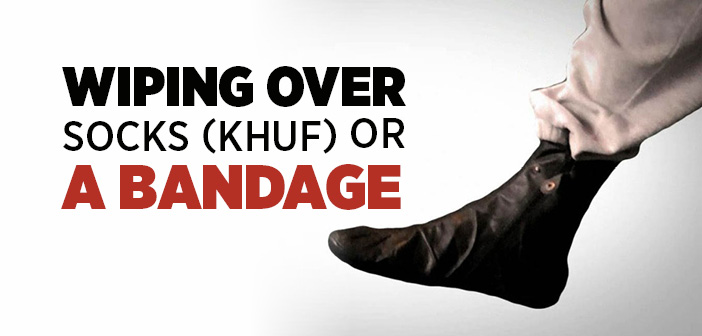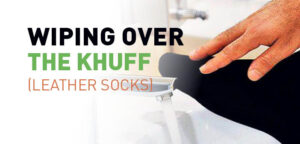
What is the condition of wiping over the khuffayn?
Ulama Institute #1
Looking to learn Arabic or memorize the Quran?
Check our Trusted Teachers

- In order to perform mas-h, a person must have worn the khuffayn after having completed wudoo in the usual way. This means that before wearing the khuff, the person must perform a regular wudoo, where the feet are washed. Then the person can wear the khuffayn, and wipe over them the next time he/she performs wudoo.
- This condition is based on an authentic hadeeth:
عن عروة بن المغيرة عن أبيه قال كُنتُ مع النبي صلى الله عليه وسلم في سفر فَأَهُويْتُ لا تُزِعِ خُفَيْهِ فَقَالَ ((دعهما فإني أدخلتهما طاهرتين)) فمسح عليهما ( البخاري )
Urwah ibn Al-Mugheerah narrated: My father said, “Once I was in the company of the Prophet on a journey [expedition] and I dashed to take off his khuffayn. He ordered me to leave them as he had put them on after performing ablution. So he passed wet hands over them.” (al-Bukhaari)
- Another hadeeth that mentions this condition is also narrated by Mugheerah
“We said, ‘O Messenger of Allah, may we wipe over our socks?’ He said, ‘Yes, if you put them on while you were in wudoo’.” (Muslim)
- This condition is very important. A person who did not do a regular wudoo and put on a pair of socks may not do mas-h over them.
What we learn from the lesson:
- The condition for mas-h over the socks is that the person has to have wudoo before putting on the socks.
“Discussion:”
- What are the conditions of mas-h?
- Which Companion narrated the hadeeth in the text reported by Al-Bukhaari and Muslim?
The Manner of Wiping over the Khuffayn
How do you wipe over the Khuffayn?
Do we use water to do mas-h?
- Islamic law prescribes that the top of the sock should be wiped.
One of the ahaadeeth that describes how the khuffayn should be wiped is narrated by Ali saying:
رأيتُ رسول الله ﷺ يَمُسحُ على ظاهر خفيه
“I saw Allah’s Messenger wipe over the top of his khuffayn.” (Aboo Daawood)
- Wiping over the bottom of the khuffayn is not the correct way to perform mas-h. This is known by the athar of ‘Ali Ibn Abee Taalib. An athar is not a hadeeth, but it is a saying of one of the Companions of Prophet Muhammad. In this regard, ‘Ali ibn Abee Taalib says:
“If the religion was based on opinion, the sole of the khuff would have been wiped rather than the top.” (Aboo Daawood)
- Scholars of the past and present have described how to wipe over the khuffayn:
- The person wets her/his hands.
- She/He lets the water drip off.
- She/He passes the hands over the khuffayn. The finger tips start at the toes and finish above the ankles.
- The following are things that should not be done when wiping over the khuffayn:
- A person should not pour water over the khuffayn either directly from the tap or from the hands and thereby soak the khuffayn.
- The hands should not wipe up to the knees. Taking the palms above the ankles is enough.
- A person should not wipe over the bottom of the feet. The proof for this is based on the athar of ‘Ali ibn Abee Taalib.
What we learn from the lesson:
- Only the tops of the khuffayn are wiped over.
- Islam is not based on opinion.







